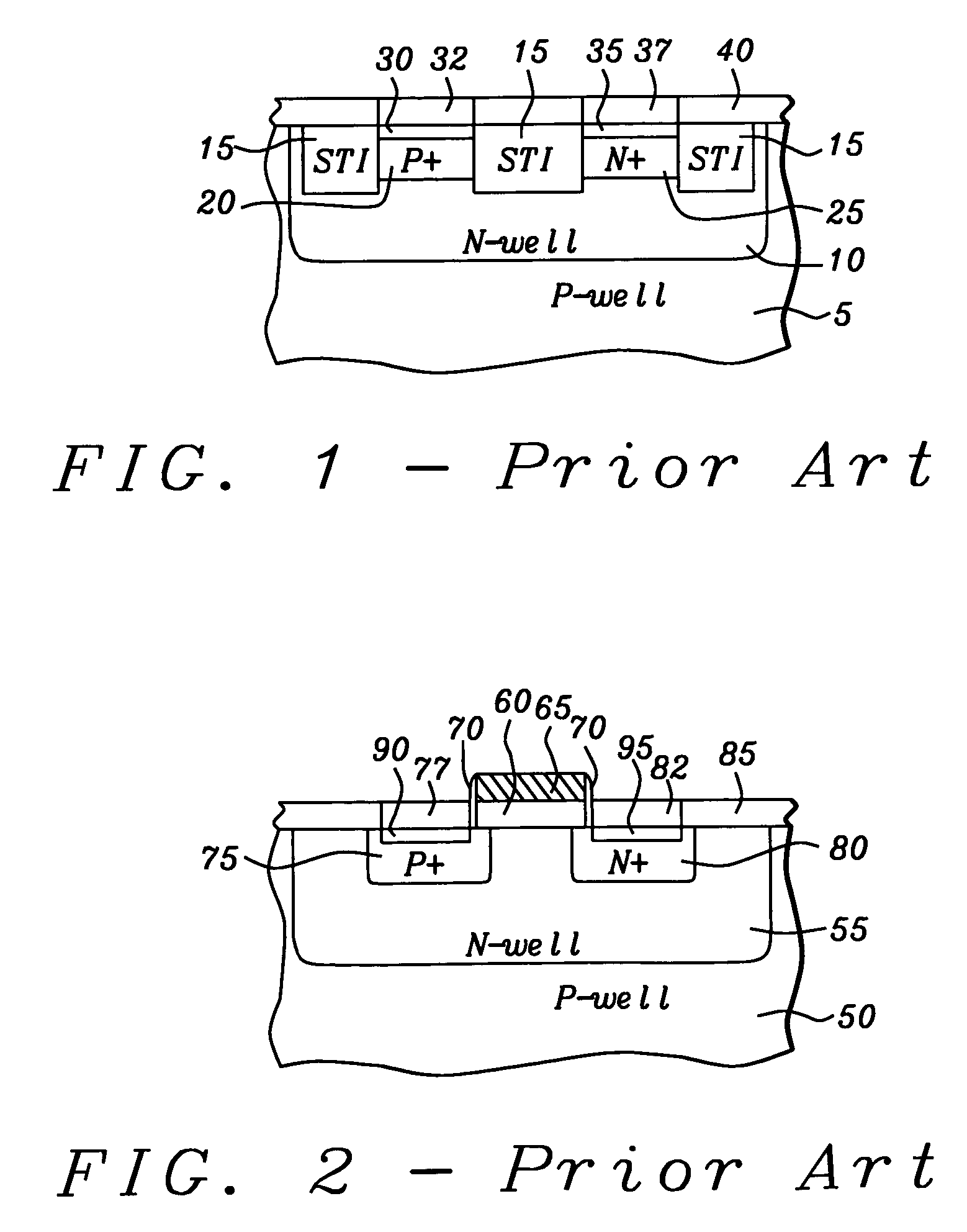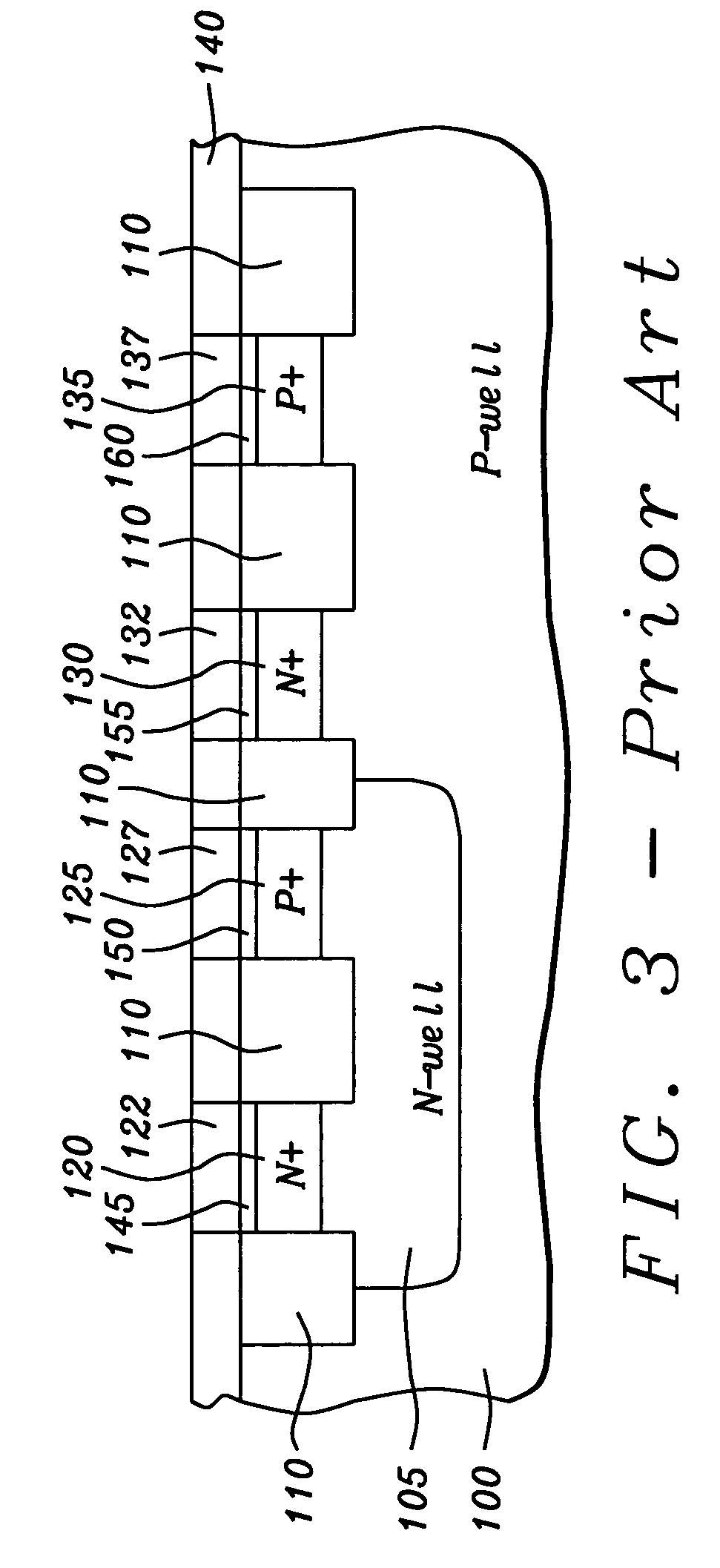Method for forming an ESD protection circuit
a protection circuit and rectifier technology, applied in the field of electrostatic discharge protection circuits, can solve the problems of affecting the performance of the device, requiring scr to be triggered, and reducing the voltage at which damage may occur
- Summary
- Abstract
- Description
- Claims
- Application Information
AI Technical Summary
Benefits of technology
Problems solved by technology
Method used
Image
Examples
second embodiment
[0056]the ESD protection circuit, as shown in FIG. 6 is connected between the signal input / output interface pad 275 and the power supply connection pad 280. The SCR is formed as described in FIGS. 4a and 4b. The diodes D1 and D2 are optional diodes placed in series with the SCR between the signal input / output interface pad 275 and the SCR. These diodes are structured as the diode D1 of the FIG. 4a and increase the holding voltage of the SCR when it is turned on. The base of the transistor Q1 and the collector of the transistor Q2 is the N-well 205 of FIG. 4a and will be referred to as the first gate of the SCR. The base of the transistor Q2 and the collector of the transistor Q1 is the P-well 200 of FIG. 4a and is referred to as the second gate of the SCR. The resistor R1 is connected between the signal input / output interface pad 275 and the first gate. The capacitor C1 is connected from the first gate to the power supply connection pad 280. In this example the power supply connecti...
third embodiment
[0059]the ESD protection circuit, as shown in FIG. 7 is connected between the signal input / output interface pad 275 and the power supply connection pad 280. The SCR is formed as described in FIGS. 4a and 4b. As described above, the base of the transistor Q1 and the collector of the transistor Q2 is the N-well 205 of FIG. 4a and is referred to as the first gate of the SCR. The base of the transistor Q2 and the collector of the transistor Q1 are the P-well 200 of FIG. 4a and is referred to as the second gate of the SCR.
[0060]The diodes D1, D2, and D3 are serially connected from cathode to anode and are structured as the diode D1 of the FIG. 4a. The anode of the first diode D1 is connected to the signal input / output interface pad 275 and the cathode of the last diode D3 is connected to the second gate of the SCR. The resistor R2 is connected to the second gate of the SCR and the cathode of the last diode D3. It should be noted that while this embodiment is implemented with the three di...
fifth embodiment
[0070]the ESD protection circuit, as shown in FIG. 9 is connected between the signal input / output interface pad 275 and the power supply connection pad 280. In this embodiment, the triggering bias circuit is a resistor R and capacitor C that are formed of a first metal oxide semiconductor (MOS) transistor M1 biased to act as the resistor R and a second MOS transistor M5 connected to form the capacitor C. The MOS transistor M2 connected to bias the MOS transistor M1 to an on condition to act as the resistor R. The junction connection between the resistor R and capacitor C is connected to an input terminal of a first inverter I1 of a group of serially connected inverters I1, I2, and I3. In this embodiment the preferred implementation of the group of serially connected inverters I1, I2, and I3 is shown as three inverters however, the number of inverters maybe adjusted according to the requirements of the design.
[0071]The SCR is formed as described in FIGS. 4a and 4b. The base of the tr...
PUM
| Property | Measurement | Unit |
|---|---|---|
| snapback voltage | aaaaa | aaaaa |
| conductivity type | aaaaa | aaaaa |
| conductivity | aaaaa | aaaaa |
Abstract
Description
Claims
Application Information
 Login to View More
Login to View More - R&D
- Intellectual Property
- Life Sciences
- Materials
- Tech Scout
- Unparalleled Data Quality
- Higher Quality Content
- 60% Fewer Hallucinations
Browse by: Latest US Patents, China's latest patents, Technical Efficacy Thesaurus, Application Domain, Technology Topic, Popular Technical Reports.
© 2025 PatSnap. All rights reserved.Legal|Privacy policy|Modern Slavery Act Transparency Statement|Sitemap|About US| Contact US: help@patsnap.com



